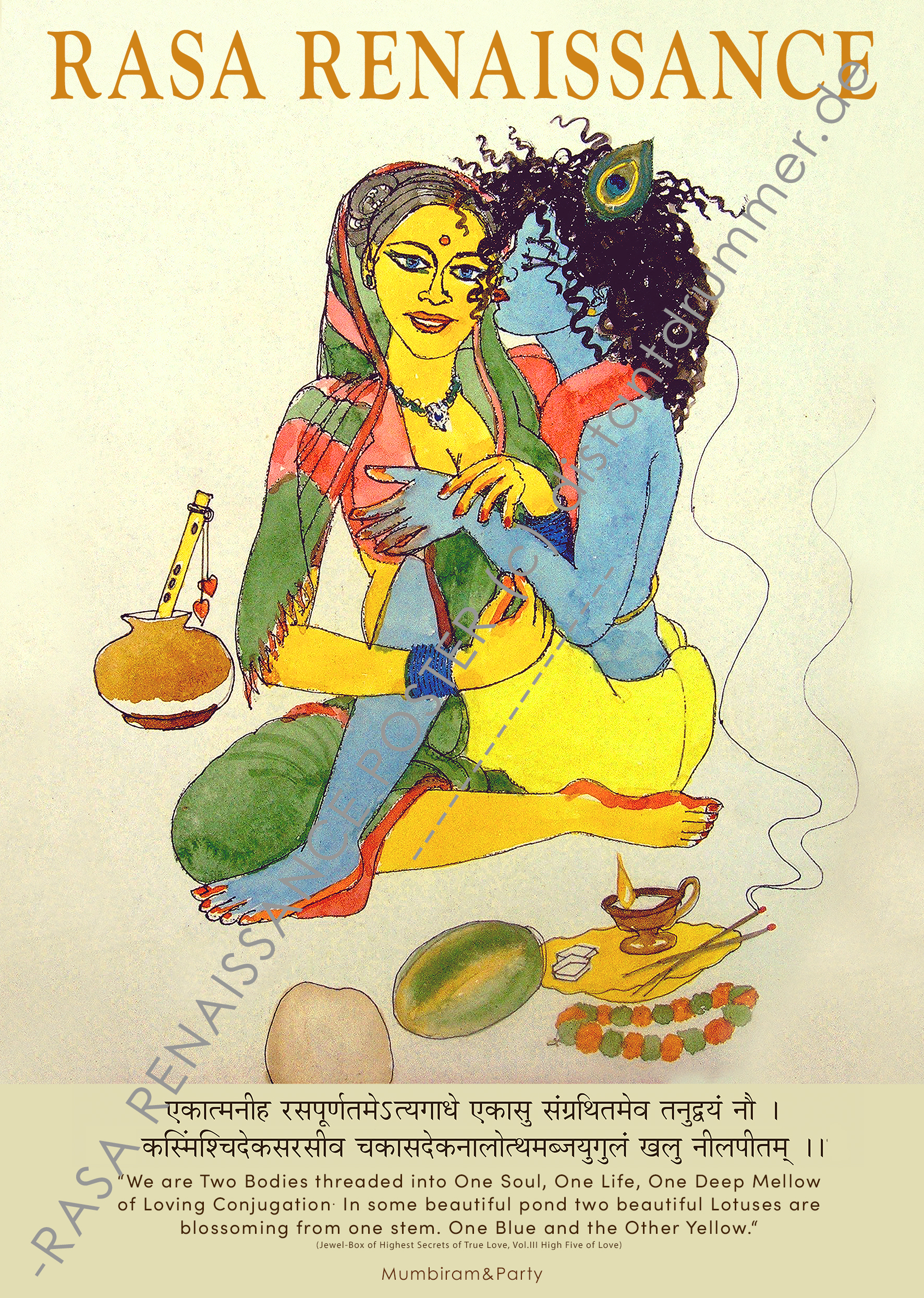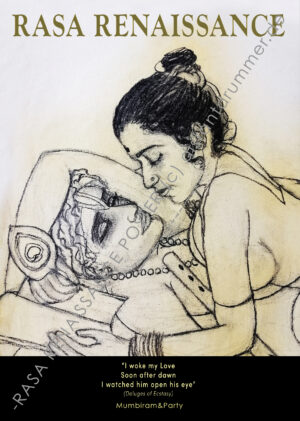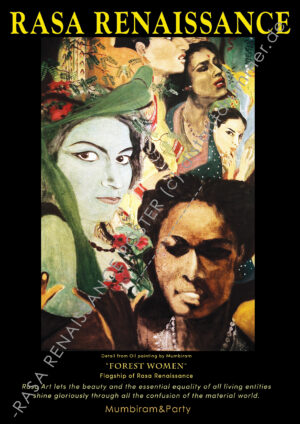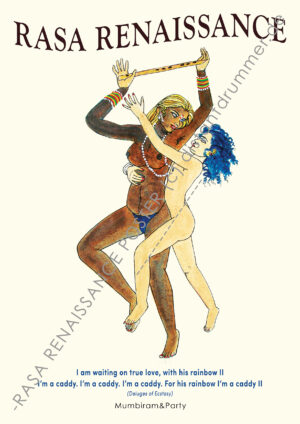“When Beloved lost his Patience” Poster
108,00 € – 208,00 €
incl. VAT plus Shipping Costs
Rasa Renaissance Poster based on original painting “When Beloved lost his Patience” by Artist Mumbiram
with Sanskrit Verse from Mumbiram’s “Jewel-Box of Highest Secrets of True Love” in Devanagari Script and its English translation
Collector’s item individually signed by Artist Mumbiram
Description
Rasa Renaissance Poster based on original painting “When Beloved lost his Patience” by Artist Mumbiram
Caption on the Poster:
Sanskrit Verse from Mumbiram’s “Jewel-Box of Highest Secrets of True Love” in Devanagari Script and its English translation:
एकात्मनीह रसपूर्णतमेऽत्यगाधे एकासु संग्रथितमेव तनुद्वयं नौ ।
कस्मिंश्चिदेकसरसीव चकासदेकनालोत्थमब्जयुगुलं खलु नीलपीतम् ॥
“We are Two Bodies threaded into One Soul, One Life, One Deep Mellow of Loving Conjugation. In some beautiful pond two beautiful Lotuses are blossoming from one stem. One Blue and the Other Yellow.”
(Jewel-Box of Highest Secrets of True Love, Vol.III High Five of Love)
Mumbiram&Party
-
High Quality Print (semi gloss paper, 195g/m2)
-
Available in 3 Sizes:
A2 (42x59cm)
A1 (59x84cm)
A0 (84x118cm)
This is a collector’s item. You will get your Rasa Poster individually signed by Artist Mumbiram.
Rasa Appreciation of original painting
“When Beloved lost his Patience”
(Watercolour, Mumbiram)
In this juxtaposition of painting and verse both are wonderfully enhancing each other.
The verse was chosen from the “Jewel-Box of Highest Secrets of True Love” which is Mumbiram’s wonderful translation of Vishvanath Chakravarti’s delightful original work “Prema Samput”. There Krishna appears to Radha disguised as a devi, a beautiful demigoddess. The devi claims to have watched all of Krishna’s dalliances at Vamshi Vat banyan on the bank of the Yamuna. The devi denounces Krishna as a philanderer, an indiscriminate womanizer and an unworthy lover. Thereupon the unsuspecting Radha opens up her heart in defense of Krishna. The verse quoted here is part of that brilliant exposé about the secrets of True Love.
This painting is just another example of Mumbiram’s unparalleled depiction of Krishna as a playful companion ready to fullfil the most secret dreams of his friends. Or has it been Krishna’s dream of such an intimate approach ?
The lines are sweet and simple. There is no pretence of, or claim to, any artistic virtuousity. It is just inviting the viewer to relish a cheerful, even witty vision of a meeting of Love and the Beloved.
Love and Beloved are meeting alone together. She has come with paraphernalia to worship him… or was she ostensibly on her way to the Sun Temple ? Anyway she has lighted the lamp and the incense sticks.There is also a papaya that is yet not cut open. There is also a garland of red and green that is lying on the floor. Behind her on the side is an empty clay pot. It must have been full of curds. Now it is empty. His flute is standing inside the pot.
This is what likely happened: He grabbed the pot of her delicious curds and greedily drank it up. He was about to start playing on his flute. Just then she grabbed the flute and put it in the empty pot. She lighted the lamp and the incense sticks. Then she was about to offer him the garland and the papaya. She was appearing extremely charming and attractive to him. He could not control himself. He lost his patience. He moved in on her and the rest is there to be seen in the picture.
The artist has left much to our imagination. We don’t have a clue where they are meeting. Is it his place or her place or is it a place of secret rendezvous ? Is it in a cave close to the Govardhan mountain ? Is she a Gopi or is she a Pulindi woman, a forest dweller ? Never mind any of that. We feel fortunate to have this glimpse of the Ujjval Rasa of conjugal love.
They indeed look like two lotuses blooming out of one stem. Here is how we decipher their merged anatomies: We don’t know how his right arm and right leg are treating her left leg. Her right leg that is folded at the knee is exposed upto the calf. Her foot is pressed against the side of his hip. The heel is pressing as if to encourage his advances. She wears no ornaments around her ankles or toes but she has coloured the soles of her feet with alaktak or mehendi. Her right arm is drawing his left leg close to herself. Her fingers are lightly pinching his left arm while his hand gently but confidently caresses her bosom that is looking proudly from a magenta coloured blouse. Fingers of her left hand are also touching his wrist, as if to stop him from touching her bosom, as if to urge him not to be rough. *
Her saree is of a tree green colour. The simple border and the stripes in the pallu are red. Those are the same red and green as in the flower garland she has brought for him. She is of a complexion similar to the colour of his dhoti. She is looking reddish because she is excited and also blushing. The outer corners of her wide open eyes are stretching to meet the ears. His half open eyes want to keep looking at the exquisite transformations in her lovely face. His pouting lips and the tip of his nose are pressing against the curves of her cheekbones. Her nostrils are lightly flaring. Her lips are gently parting in a faint smile as she utters a low sweet nothing. Her precious looking necklace sits pretty at the base of her graceful neck. She has swept back her hair in a bunch that is peeping out of the pallu that is still covering her head. She has just arrived. Simple earrings that match the necklace are adorning her shapely ears that are exposed to great advantage. He wears no decorations apart from the iconic peacock feather and a red shoulder cloth. His hair defies any order. It looks electrified at the ecstatic joy of their meeting.
In sweet contrast and concordance they indeed look like two lotuses blooming from one stem, one Blue and the other Yellow.
* (Such contradictory outwardly expression of attraction and repulsion, invitation and rejection, delight and distress, surprise and familiarity comes closest to what is called kilakinchita expression of inner emotional state by authorities on Rasa Theory such as Rupa Goswami’s Ujjwalanilamani or Bharat Muni’s Natyashastra. It must be added that the situations that are depicted in such visual renderings by Mumbiram or are expressed in the short and sweet verses of Mumbiram’s “Deluges of Ecstasy” often defy categorization mentioned by these authorities. They are in a class of their own !)
Related products
-
- Rasa Renaissance Poster
“I woke my Love” Poster
- 108,00 € – 208,00 €
- Select options This product has multiple variants. The options may be chosen on the product page
-
- Rasa Renaissance Poster
“Forest Women” Poster
- 108,00 € – 208,00 €
- Select options This product has multiple variants. The options may be chosen on the product page
-
- Rasa Renaissance Poster
“Capturing the Flute” Poster
- 108,00 € – 208,00 €
- Select options This product has multiple variants. The options may be chosen on the product page




